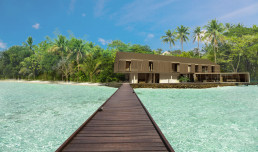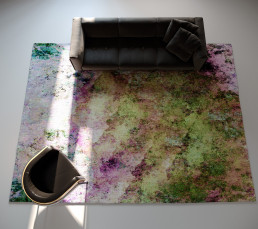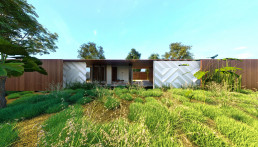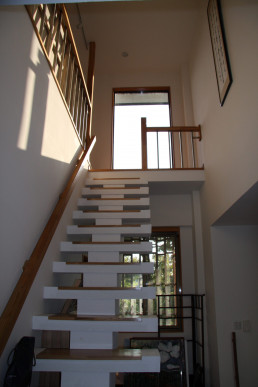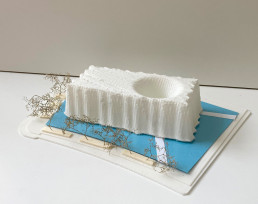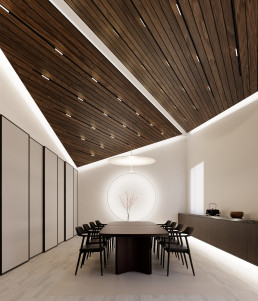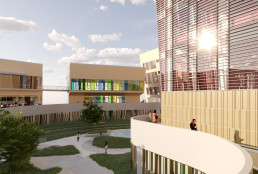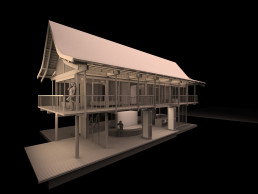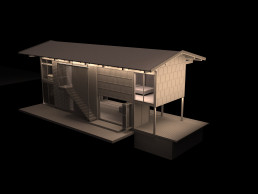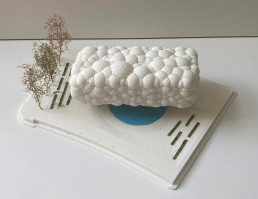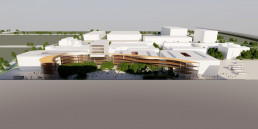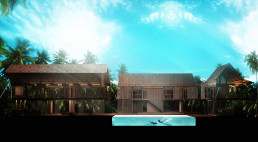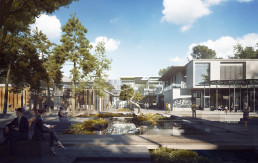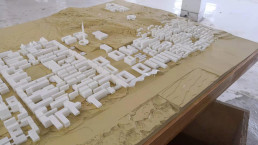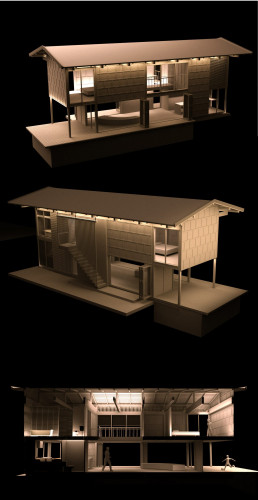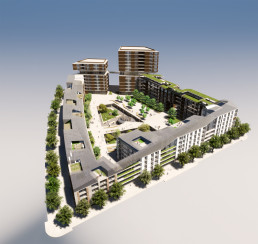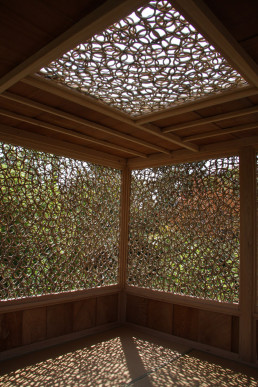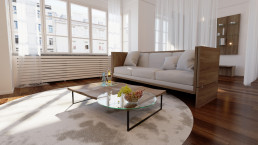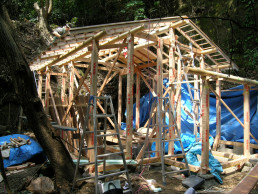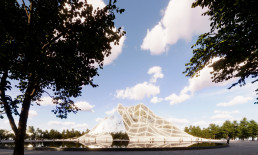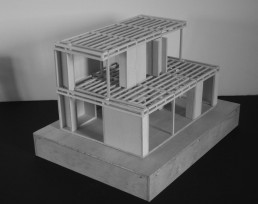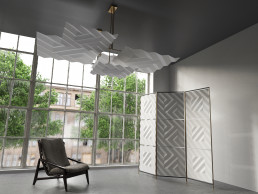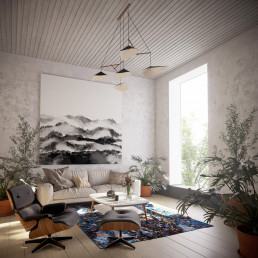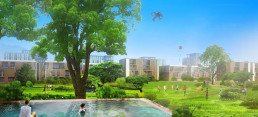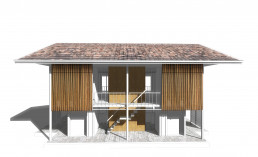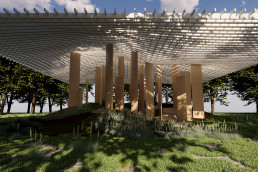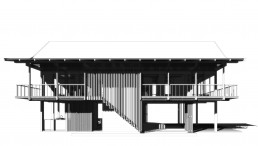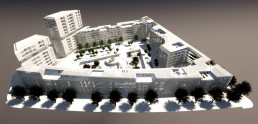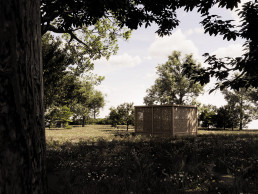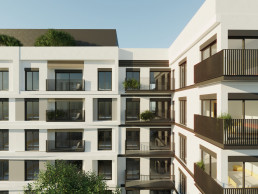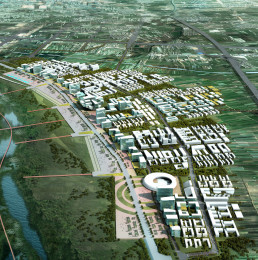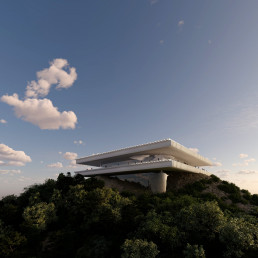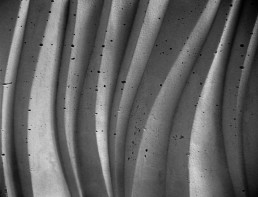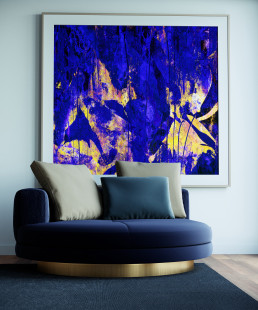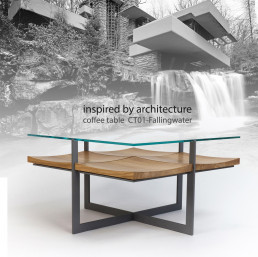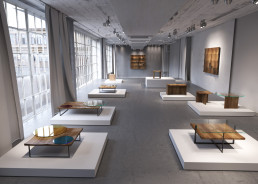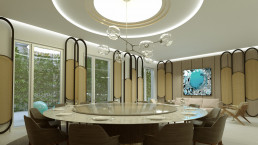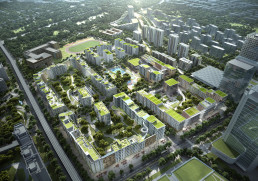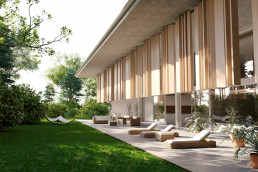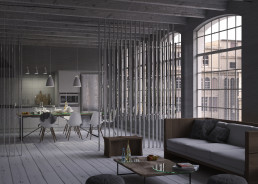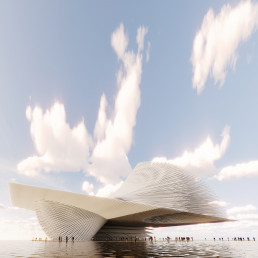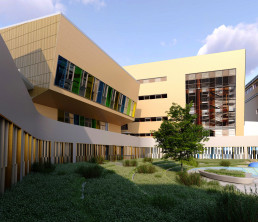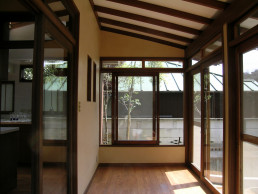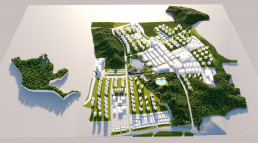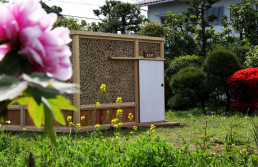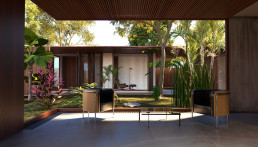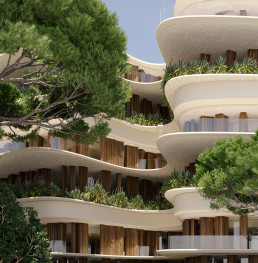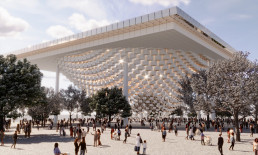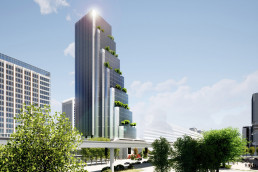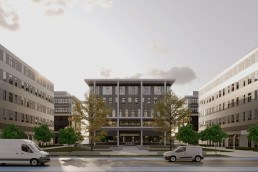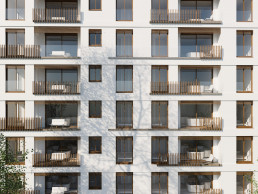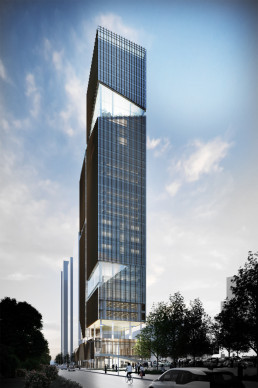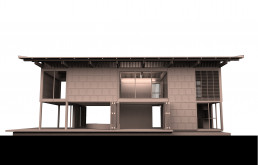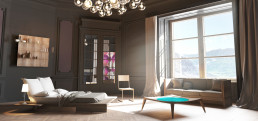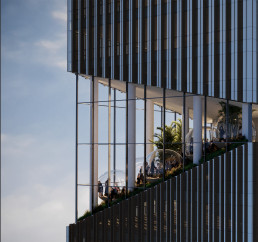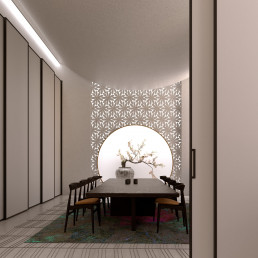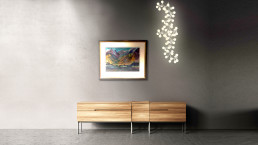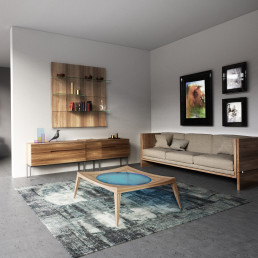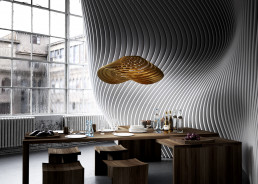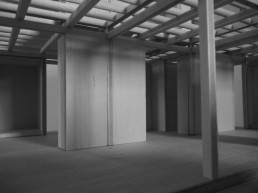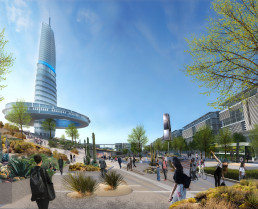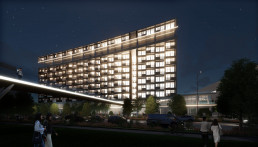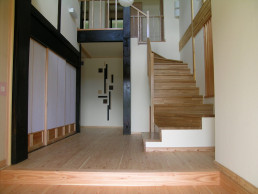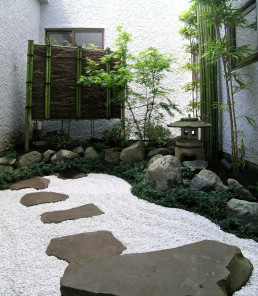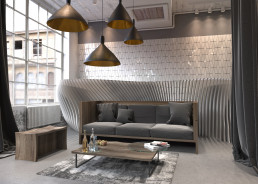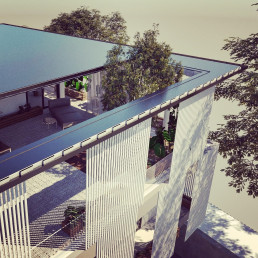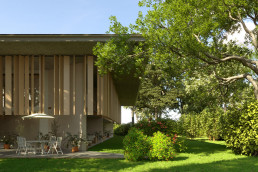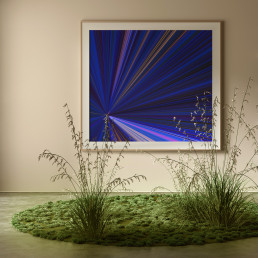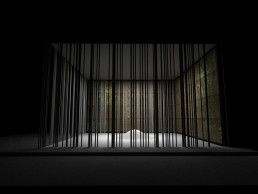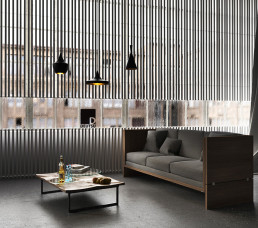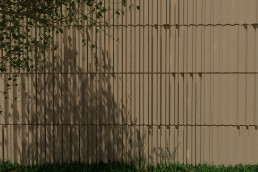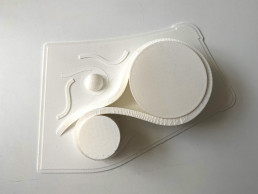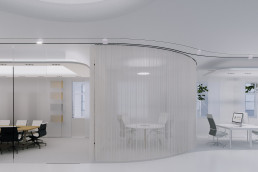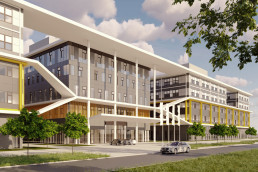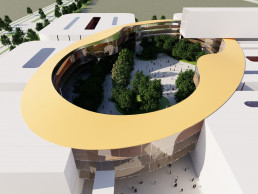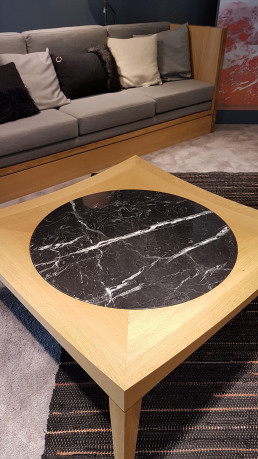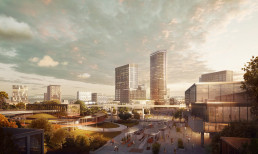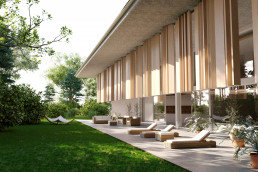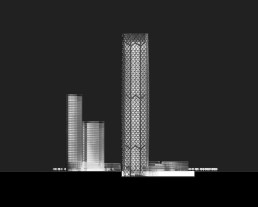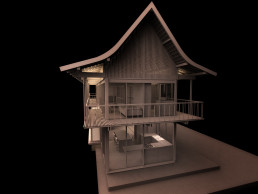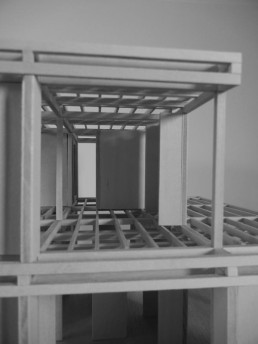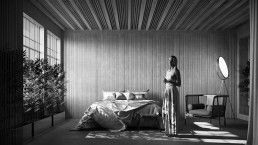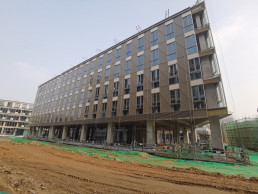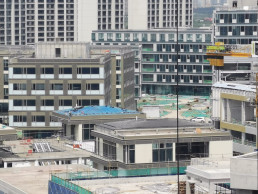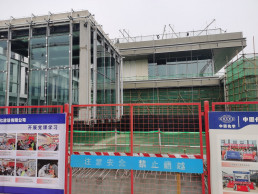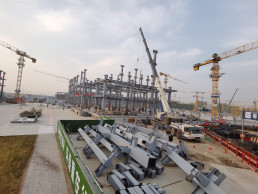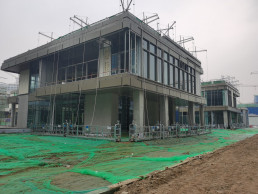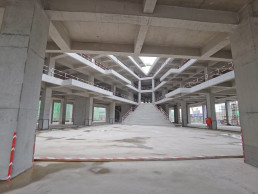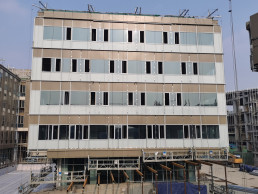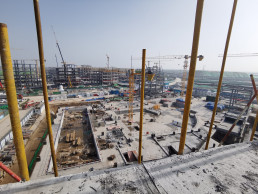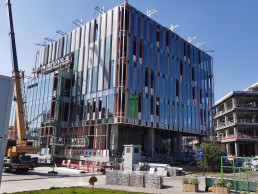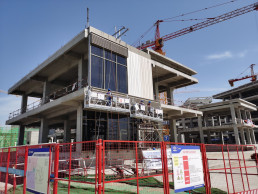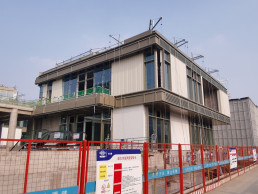architecture + consulting
cities for people
commercial experiences
cultural and educational buildings
inside & outside
interior & art spaces
custom made furniture design
curiosity and excitement
our vision
Our vision is to be a catalyst for positive change in regions where the impact on climate and environmental issues is most profound. By sharing our expertise and adopting innovative approaches, we aim to empower local communities and planners to embrace sustainable design and practices. Together, we envision a world where architects and planners unite across borders, transcending cultural differences, to co-create sustainable urban spaces and buildings that respect nature, protect biodiversity, and prioritize the well-being of people. Through these collaborative efforts, we can make a real worldwide shift towards a more harmonious relationship between humans and the planet, safeguarding the Earth for generations to come.
how we work
We see our work with our customers as a joint project in which we as planners competently advise and support our clients in addition to the planning services to be provided. PLANSPEKTRUM is an architectural practice with local and international planning experience. We want to think about tomorrow's developments and encourage our clients to become motivated to do better. At our architecture office, we are committed to working and actively engaging in regions with significant impact on the rest of the world. We recognize the urgency to support and collaborate with communities in these countries with rising economies, as their transformation is crucial for creating a global shift towards a sustainable and resilient future. We believe that our collective efforts and shifting parameters there for the better can make a meaningful difference in shaping a better world.
In our office, the partners bring together the experience of 20 years of work in Germany, China, Hong Kong, and Japan. The project experience includes larger urban planning concepts, office and residential high-rise buildings, hotels, apartment buildings, single-family houses, and interiors as well as sustainable and high-quality furniture design and craftsmanship.
Does AI create better design and architecture ?
While AI-generated designs may be visually stunning and conceptually appealing, their feasibility in real-world construction can sometimes be questionable. The transition from a virtual design to a tangible building requires careful consideration of structural integrity, material availability, construction methods, and compliance with regulations.
AI has the potential to revolutionize the way architects and urban planners analyze complex environmental data dependencies, such as sunlight, noise, wind patterns, building shapes, and glass values. By harnessing the power of AI algorithms, these professionals can efficiently process vast amounts of data and gain valuable insights that influence sustainable and thoughtful design decisions.
Through AI-driven simulations and predictive modeling, architects can assess how different building shapes, orientations, and materials impact factors like sunlight exposure and thermal performance. AI can help optimize energy efficiency by suggesting ideal window placements, shading solutions, and material compositions to reduce reliance on artificial lighting and heating. Furthermore, AI can aid planners in evaluating noise patterns to design more peaceful and harmonious environments. It can analyze wind flow around buildings and suggest modifications to minimize discomfort and enhance natural ventilation, reducing the need for energy-consuming HVAC systems.
LONG-TERM-THINKING
Since we grew up in the former eastern zone, where a lot of material supply was limited due to the east-west cold war border, we learned to have things for a longer time period. We needed to take care of objects more and needed to repair things more. People and items, which are always alongside there with you are creating the concept of long-term thinking.
We are all driven by the fast-changing world, which could change within some days and months completely. Information is constantly changing and updating through all media platforms. We design and develop buildings and objects which should sustain within the fast time. They are not artificial data or virtual constructs, they really exist and persist, and they are touchable. So the long-term thinking of the beneficial use and presence of built environment is crucial and is about 30-50 years at least.
We lived the last years with the pandemic Covid 19 and learned a lot about, how we could get along with such problems. We also learned that life and work must go ahead and should continue in a motivated manner to overcome that crisis. I think we got stronger and more confident to manage these unprecedented times. Long-term thinking is part of the long-term motivation to enrich the world with values, which persists the time. Long-term thinking is the concept of being motivated in a world of fast changes and speed up life.
Why beauty matters
Educated and trained with the concept of form and style are secondary and the idea it is all about. After working for 20 years in the design and architecture field, in Japan, China, and Germany I come to the conclusion, that something changed about that paradigm. Beauty was always the touching part of all the different buildings and designs, I still remember, That beauty is still omnipresent in my memories of places and keeps me remembering the places I really felt nice with. So beauty is more centrally positioned than we might think in our perception as designers and architects.
Beauty creates positive feedback and normally spread to the minds of the users. So it is also an essential part of the perception besides the functional working space and design approach. So we need foster beauty in projects to spread motivation and optimism as architects and designers.
this is a difficult question since sustainability does not aim at first sight for beauty. Its aim for being responsible for the materials and available supply as well as the way it will be one day in the future able to be part of the recycling process to release its materials for new processes. But in general, beauty could be the result if the sustainable design does everything right. Beauty will appear naturally from such projects without the need to add a beautifier.
What means cradle to cradle to your business ?
Cradle to cradle is known in the architecture scene, but not yet really consequent shifted. All that we do and create in terms of using materials needs to be part of an ecosystem of materials. There is a limited source of materials on this planet. We need to design buildings, where all materials could be reused after the building finished its life purpose of use. So we need to think more material focused, when it comes to the overall life cycle of a building.
Since its about binding CO2 Emission, all-natural fiber would be very helpful to use. We see recently much more use of timber, which could be used as a structural element as well as defining Interior and exterior walls & facades. Rammed earth is also a very promising material, which is recently used by more architects and requested by responsible clients.
Since its a design approach, which needs more planning time and in the end uses more durable and long-term rated products, the cost will be higher, than the average building standard. There are a lot of parameters to control the costs of such a building. There are a lot of things still to learn about cradle-to-cradle design, especially since it needs from our side as architects a lot of communicating with clients to make them understand the huge benefit of their project.
There was a proposal for a building within the rice field and there were two pictures shown – the one before and the one after construction. Interestingly and surprisingly there was no difference between the two pictures. This surprising fact, that architecture basically doesn’t need a face to be good and stunning, was a new experience and changed our thinking.
What do you think about BIM and it's implementation during construction process ?
Implementing BIM during the construction process on-site and collaborating with companies still using traditional AutoCAD (ACAD) drawings can be a challenging endeavor. While BIM offers numerous benefits, such as improved efficiency, better coordination, and enhanced data management, its successful implementation requires overcoming several obstacles. Furthermore, the transition from 2D ACAD drawings to 3D BIM models demands a significant shift in mindset and workflow for both architects and construction teams. While BIM offers more comprehensive information and better visualization, it requires additional training and adaptation for those accustomed to working with 2D drawings. This learning curve can slow down the adoption of BIM on construction sites.
I think there are many aspects, which make sense to working with such tools.The bigger scale of projects allows us now as a small office to handle buildings and check it better. In the past, we were not able to work on bigger projects because of the huge amount of drawings that needed to be produced and revised manually. Therefore we are using our change to distribute also ideas and concepts for the future on a bigger scale. Working collectively on a teamwork central file-based project also helps to integrate oneself into the project team. During Corona remote working together on one file was a good way to be a direct distribute work of into the project, which everybody on the team noticed. Building a useful BIM model together with our team is good for everyone, who needs to get specific data or plan out of the model. So it satisfy somehow also to have build up together meaningful data.
ARCHICAD latest release with BIM CLOUD teamwork
What is the motivation for your office to work in Asia ?
Working as architects and planners in Asia presents a unique and crucial opportunity, given the worldwide impact of climate change and the significant challenges the continent faces, as opposed to Europe, which has a more established development and efficient waste production management system. Here’s an explanation of why this is so important:
1. Unprecedented Urbanisation: Asia is experiencing rapid urbanisation, with millions of people moving to cities each year. This urban growth results in increased construction and infrastructure development. Architects and planners in Asia have the opportunity to shape these rapidly growing cities in sustainable ways, ensuring that future urbanization is environmentally friendly.
2. Climate Change Mitigation: Asia is one of the regions most affected by climate change. Architects and planners can play a pivotal role in designing buildings and cities that are resilient to climate change impacts. Energy-efficient buildings, sustainable infrastructure, and green urban planning can significantly reduce carbon emissions.
3. Resource Efficiency: Unlike Europe, where resource efficiency and waste management are relatively well-established, many Asian countries are still grappling with resource-intensive practices. Architects can introduce resource-efficient building designs that minimize waste, optimize material usage, and reduce energy consumption.
4. Biodiversity Conservation: Asia is home to rich biodiversity, but rapid development often threatens local ecosystems. Architects and planners can incorporate principles of ecological design and green spaces into urban development, contributing to biodiversity conservation.
5. Social Impact: In Asia, the social implications of architecture and planning are profound. Architects can address issues such as overcrowding, housing affordability, and access to basic services, improving the quality of life for millions of people.
6. Innovative Solutions: Many Asian countries are open to innovation and new technologies. Architects and planners can introduce cutting-edge solutions in sustainable building materials, renewable energy integration, and smart city technologies, driving global innovation.
7. Educational Impact: Working in Asia provides an opportunity to educate clients, governments, and communities about sustainable practices. Architects and planners can be advocates for sustainable development and inspire others to follow suit.
8. Global Collaboration: Asia’s challenges are not confined to the continent; they have global implications. Architects and planners working in Asia can contribute to international efforts to combat climate change and promote sustainability.
9. Market Growth: The Asian market for sustainable architecture and planning is growing rapidly. This presents economic opportunities for professionals in the field, making it a viable career choice.
10. Long-Term Impact: The decisions made by architects and planners today will shape the built environment for generations. By working in Asia, professionals can have a lasting impact on how cities and regions develop sustainably.
While Europe has made significant progress in sustainability, the challenges in Asia are immense, and the potential for positive change is equally substantial. Architects and planners who choose to work in Asia can contribute to addressing global environmental challenges and leave a meaningful legacy of sustainability.
As architects and planners, our ability to effect change might seem incremental when working on individual projects. However, in Asia, where vast amounts of square meters are being developed, even a slight improvement can have a substantial impact when scaled up. Consider the scenario where we enhance insulation thickness or opt for higher-quality glass. In a large-scale project, such changes can result in significant energy savings and efficiency gains. For instance, if the glass quality is 10% better than the average, the cumulative effect across the entire project can be substantial. On the other hand, if we were to renovate one more house in Germany, it would likely have a negligible impact in comparison. Working in Asia offers us the opportunity to make meaningful contributions to sustainability on a larger scale.
motivated people with similar visions, a trusted network of partners and local collaborators and a good interchanging Platform to work from everywhere together
news
what we work on
what interests and inspires
2023-12-04
Protected: Panoramic Villa
2023-09-08
Showroom Medical-Device-Company
2023-05-28
visual inventory : stone
2023-05-21
our visual inventory : wood
think, develop & build together
for contact and project inquiries please send to the following email:
PLANSPEKTRUM GbRKyreinstraße 881371 MünchenPhone +49 89 | 4622 9112Web: www.planspektrum.deE-Mail buero@planspektrum.de
Website Terms and Conditions of Use
1. Terms
By accessing this Website, accessible from www.planspektrum.de, you are agreeing to be bound by these Website Terms and Conditions of Use and agree that you are responsible for the agreement with any applicable local laws. If you disagree with any of these terms, you are prohibited from accessing this site. The materials contained in this Website are protected by copyright and trademark law.
2. Use a License
Permission is granted to temporarily download one copy of the materials on PLANSPEKTRUM GbR's Website for personal, non-commercial transitory viewing only. This is the grant of a license, not a transfer of title, and under this license, you may not:
- modify or copy the materials;
- use the materials for any commercial purpose or for any public display;
- attempt to reverse engineer any software contained on PLANSPEKTRUM GbR's Website;
- remove any copyright or other proprietary notations from the materials; or
- transferring the materials to another person or "mirroring" the materials on any other server.
This will let PLANSPEKTRUM GbR terminate upon violations of any of these restrictions. Upon termination, your viewing right will also be terminated and you should destroy any downloaded materials in your possession whether it is printed or electronic format.
3. Disclaimer
All the materials on PLANSPEKTRUM GbR’s Website are provided "as is". PLANSPEKTRUM GbR makes no warranties, may it be expressed or implied, and therefore negating all other warranties. Furthermore, PLANSPEKTRUM GbR does not make any representations concerning the accuracy or reliability of the use of the materials on its Website or otherwise relating to such materials or any sites linked to this Website.
4. Limitations
PLANSPEKTRUM GbR or its suppliers will not be held accountable for any damages that will arise with the use or inability to use the materials on PLANSPEKTRUM GbR’s Website, even if PLANSPEKTRUM GbR or an authorize representative of this Website has been notified, orally or written, of the possibility of such damage. Some jurisdiction does not allow limitations on implied warranties or limitations of liability for incidental damages, these limitations may not apply to you.
5. Revisions and Errata
The materials appearing on PLANSPEKTRUM GbR’s Website may include technical, typographical, or photographic errors. PLANSPEKTRUM GbR will not promise that any of the materials in this Website are accurate, complete, or current. PLANSPEKTRUM GbR may change the materials contained on its Website at any time without notice. PLANSPEKTRUM GbR does not make any commitment to update the materials.
6. Links
PLANSPEKTRUM GbR has not reviewed all of the sites linked to its Website and is not responsible for the contents of any such linked site. The presence of any link does not imply endorsement by PLANSPEKTRUM GbR of the site. The use of any linked website is at the user’s own risk.
7. Site Terms of Use Modifications
PLANSPEKTRUM GbR may revise these Terms of Use for its Website at any time without prior notice. By using this Website, you are agreeing to be bound by the current version of these Terms and Conditions of Use.
8. Governing Law
Any claim related to PLANSPEKTRUM GbR's Website shall be governed by the laws without regard to its conflict of law provisions.
vision
contribute back & being responsible towards our wonderful blue planet
about us
- we are a team of international architects & designers
- curiosity and sustainability are our motivation
- realizing projects with our clients as a team together
- over 20 years of work experience with projects in Germany, Japan, China
buero
PLANSPEKTRUM GbR
Kyreinstrasse 8
81371 München
Germany

